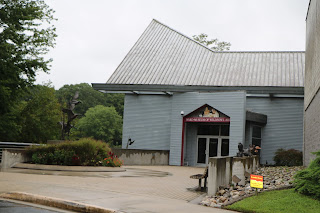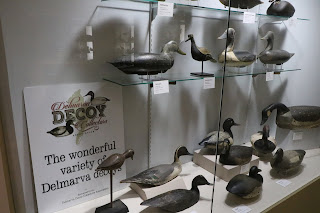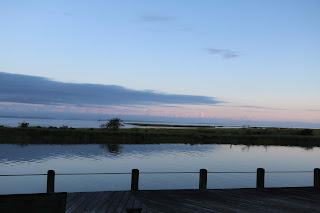The Road Scholar program, which is about a four hour drive, begins late this afternoon. Still overcast and warm as we head to Gwynne's in West Chester for a blueberry pancake breakfast! Yum.
We will head south, through the Maryland eastern shore and Delaware to Chicoteague Island at the northernmost top of Virginia. We hit some rain on and off but nothing too bad. We stop in Salisbury, Maryland for a quick lunch at Arby's and then visit the Ward Museum of Wildfowl Art which is on the campus of Salisbury University.
Named for Lem and Steve Ward, who were local decoy carvers and painters, the museum features a collection of decoys as well as other wood carvings. Ann Suthowski is our tour guide - very knowledgeable and enthusiastic!
The decoys include very old ones from the 1920's. Some are very rough and some made with canvas.
You can see the amazing progression of detail and craftsmanship as practical hunting creations evolved to today's pieces of art. Some of them can bring 5 figures based on who carved them, when, how many were made, etc.
There is information, too, about waterfowl and their history. The growing urban population (it doubled between 1840 and 1850!) around the Chesapeake Bay led to market gunning, use of feathers in fashion, and over-hunting. As a need for waterfowl protection became apparent, the 1918 Migratory Bird Treaty was passed (which Trump has recently reversed much to conservationists' chagrin).
Our guide explained the competitions held annually and showed several of the recent winners in various categories. Some of the birds were very intricate with individual delicate feathers.
We continued on another hour or so to Chincoteague Island and the Island Resort. Checked in and then registered with Road Scholar and met our Group Leader, Cindy Faith, who is native to the island. Rooms are nice, with small balconies facing the bay. Obviously pretty old but decently maintained.
We've got our own flock of waterfowl that seem to have free rein of the town.
There are 36 of us in the program, from various points in the US. We meet at 5:30 to go to Etta's On the Bay for dinner. Etta's overlooks the island and nearby Assateague Lighthouse. (Still rainy).
On the way to dinner, Cindy explains that this weather is "just" a Nor'easter - nothing to do with the Hurricane out there in the Atlantic. They've had a lot of rain and a few of the roads are impassible, but - no worries!
Cindy also explains some history of the area. Chincoteague was named for a Native American tribe who lived here thousands of years ago when it was not an island. Europeans began setting here, mostly indentured servants who married native women and initially were farmers. In the 1800's lifestyle changed and seafood became the #1 industry. Interestingly, during the Civil War, Chincoteague remained loyal to the Union when the rest of Virginia joined the Confederacy. The vote was 132-1 NOT to succeed. There were no slaves on Chincoteague. Fishermen received special passes to bypass the Union blockades and trade their seafood for other supplies in Baltimore, Philadelphia and New York. Chincoteague oysters, crabs and other seafood were extemely popular into the 1920's.
Of course the book "Misty of Chincoteague" made the ponies and the island famous. Virginia has permits for 150 ponies and takes good care of them. Cindy made a point of saying that there are another group of ponies on the northern end of the island - which is in Maryland - and they are not so well cared for and sometimes give them all a bad name. There is an annual "penning" or round-up of the ponies during which time some are sold to maintain the optimum number the land will support.













No comments:
Post a Comment